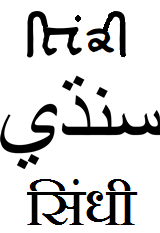Language/Sindhi/Grammar/Adjectives
Hi Sindhi learners! 😊
In today's lesson, we will be discussing adjectives in the Sindhi language. Adjectives are words that describe or modify other words, usually nouns or pronouns. They can be used to give more information about a person, place, thing, or idea. In this lesson, we will look at how to use adjectives in Sindhi and some of the rules that govern their usage.
Types of Adjectives
Adjectives can be divided into two main categories: descriptive adjectives and possessive adjectives.
Descriptive Adjectives
Descriptive adjectives are used to describe the qualities of a noun or pronoun. Examples of descriptive adjectives include: big, small, tall, short, happy, sad, etc.
In Sindhi, descriptive adjectives come before the noun they are describing. For example:
- Khoobsoorat larki (beautiful girl)
- Chota bacha (small child)
Possessive Adjectives
Possessive adjectives are used to show ownership or possession. Examples of possessive adjectives include: my, your, his, her, its, our, their, etc.
In Sindhi, possessive adjectives come after the noun they are describing. For example:
- Larki ka kapra (girl's clothes)
- Bache ki kitaab (child's book)
Adjective Agreement
In Sindhi, adjectives must agree with the noun they are describing in terms of gender and number. This means that the adjective must match the gender and number of the noun it is describing.
For example:
- Khoobsoorat larki (beautiful girl)
- Khoobsoorat larke (beautiful boy)
In the above examples, the adjective khoobsoorat (beautiful) changes to match the gender of the noun it is describing.
Similarly, when describing a plural noun, the adjective must also be plural. For example:
- Khoobsoorat larkian (beautiful girls)
- Khoobsoorat larke (beautiful boys)
In the above examples, the adjective khoobsoorat (beautiful) changes to match the number of the noun it is describing.
Adjective Order
When using multiple adjectives to describe a noun, the order of the adjectives is important. In Sindhi, adjectives should be placed in the following order:
1. Opinion 2. Size 3. Age 4. Shape 5. Color 6. Origin 7. Material 8. Purpose
For example:
- Choti, khoobsoorat, purani kitaab (small, beautiful, old book)
In the above example, the adjectives are placed in the correct order.
Conclusion
In this lesson, we have looked at how to use adjectives in Sindhi. We have discussed the different types of adjectives, how to form them, and the rules governing their usage. We have also looked at the order in which adjectives should be placed when describing a noun.
We hope that this lesson has helped you to gain a better understanding of adjectives in Sindhi.
If you have any questions, please ask them in the comments section below.
Feel free to edit this wiki page if you think it can be improved. 😎

